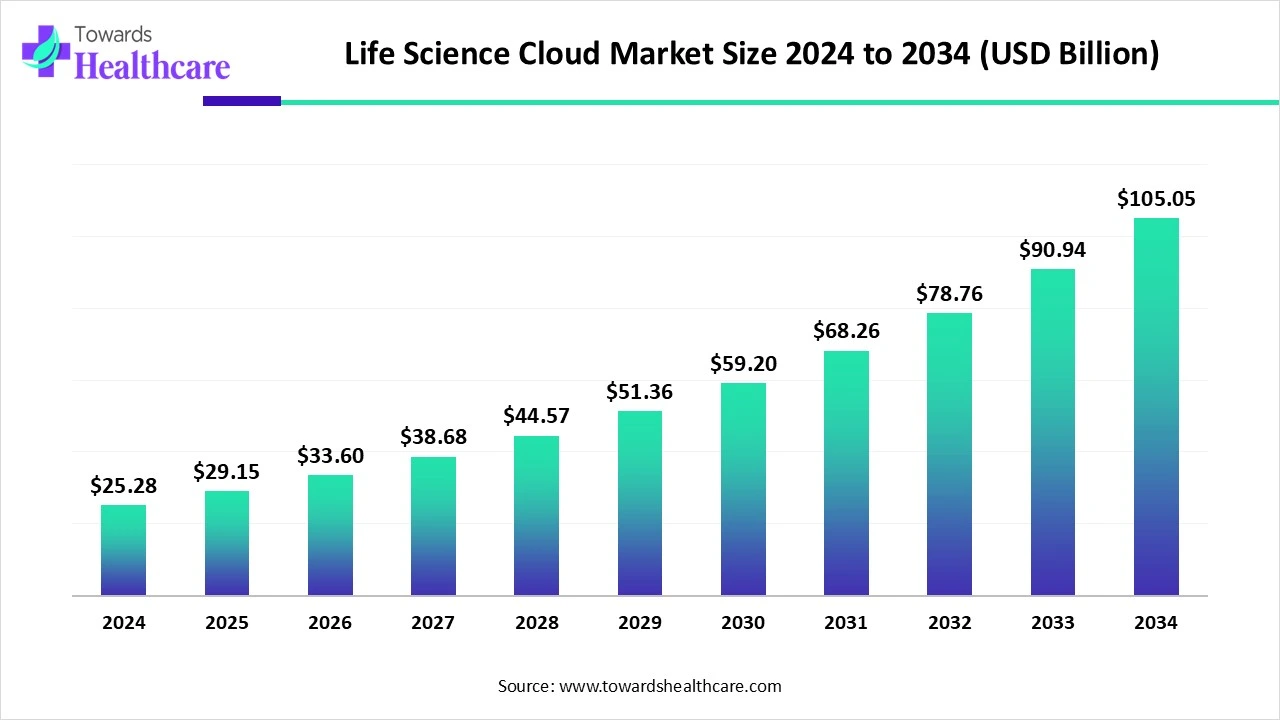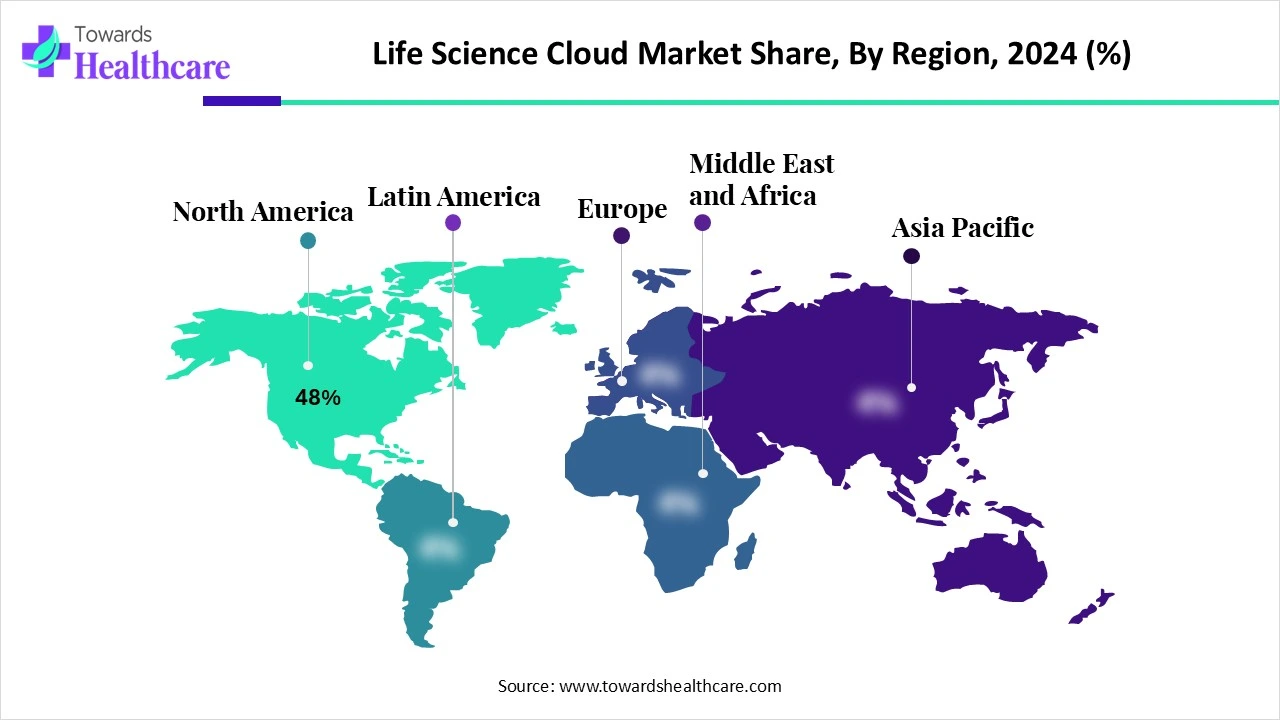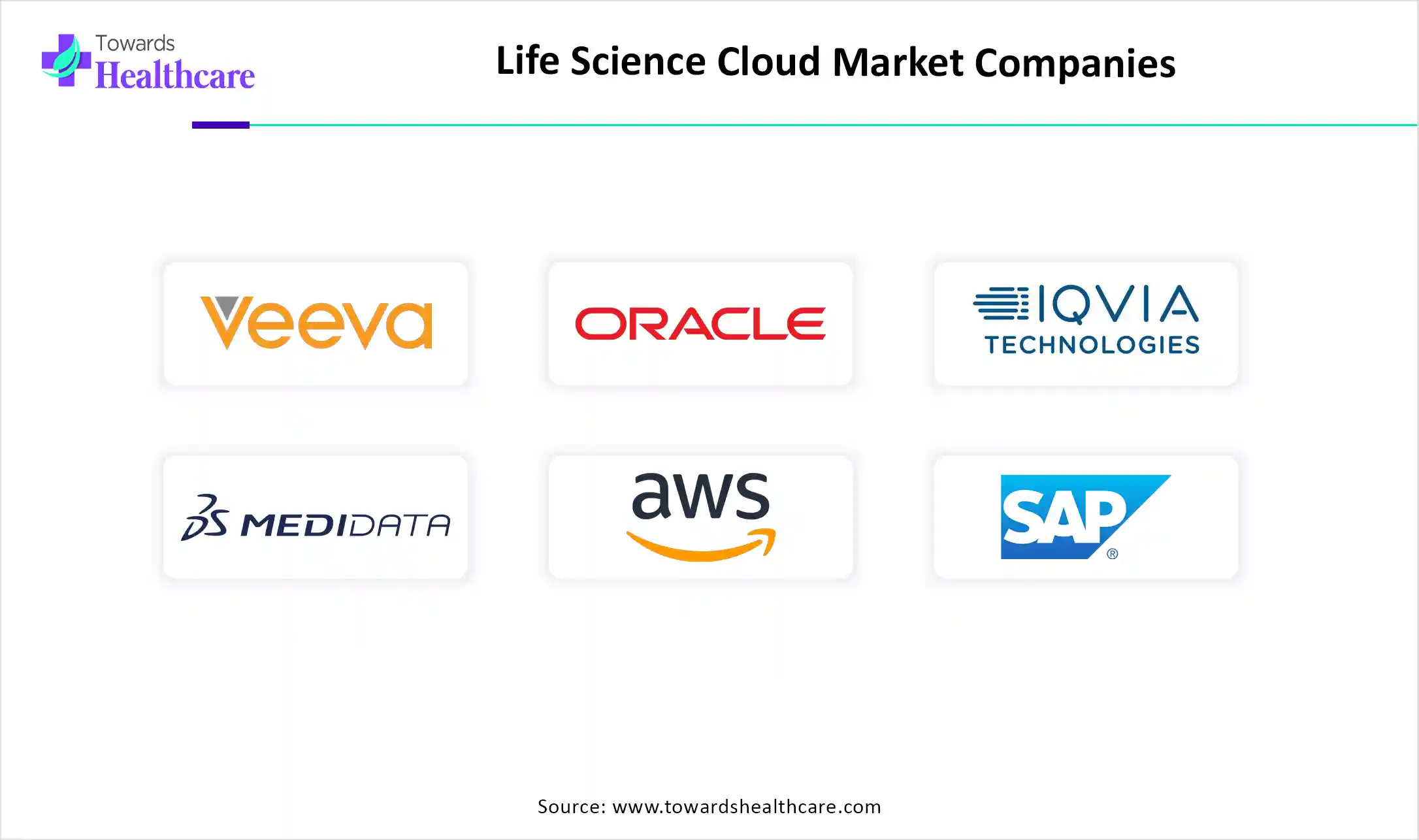November 2025

The global life science cloud market size is calculated at US$ 25.28 billion in 2024, grew to US$ 29.15 billion in 2025, and is projected to reach around US$ 105.05 billion by 2034. The market is expanding at a CAGR of 15.27% between 2025 and 2034.

The global life science cloud market is experiencing major growth due to many advantages, like scalability, remote accessibility, and affordability of cloud solutions. As well as, in case of genomics and diagnostics, cloud solutions support to development of novel therapies, diagnostic options, and biomarker detection by analyzing large volume of datasets, with progress in personalized medicine and treatments.
Although in the case of clinical trials, cloud-driven solutions can assist in simplifying clinical trial management, optimizing patient selection, and providing remote monitoring. Thus, advancements in AI, ML are boosting the adoption of cloud solutions in widespread life science areas, such as drug discovery and development, precision medicine, and clinical trials.
| Metric | Details |
| Market Size in 2025 | USD 29.15 Billion |
| Projected Market Size in 2034 | USD 105.05 Billion |
| CAGR (2025 - 2034) | 15.27% |
| Leading Region | North America |
| Market Segmentation | By Deployment Mode, By Solution Type, By Application, By End User, By Region |
| Top Key Players | Veeva Systems Inc., Oracle Life Sciences, IQVIA Technologies, Medidata Solutions (Dassault Systèmes), Microsoft Azure for Health & Life Sciences, Amazon Web Services (AWS), Google Cloud for Life Sciences, SAP SE, Salesforce Health Cloud, Accenture Life Sciences Cloud, PerkinElmer Informatics (Revvity), LabVantage Solutions Inc., Benchling, Dotmatics (Insightful Science), Certara, Curebase, DNAnexus, CloudLIMS, ArisGlobal, Cloudbyz |
The life science cloud market refers to cloud-based infrastructure, platforms, and software solutions designed specifically for pharmaceutical, biotechnology, diagnostics, and medical device companies. These solutions enable secure data storage, scalable computing, collaborative R&D, clinical trial management, regulatory compliance, real-world evidence analytics, AI-driven drug discovery, and supply chain optimization. The shift toward digital transformation, decentralized research, data interoperability, and GxP compliance is fueling demand for flexible, cloud-native platforms across the life sciences value chain.
In 2025, AI is playing an immense role in the rapidly growing market, thanks to major optimizations in algorithms and computing power, which have enabled it to tackle more difficult problems in the life sciences. As well as around the globe, the rising availability of vast datasets in life sciences, like genomic data and clinical trial data, propels for AI tools to examine and make predictions.
In the life science sector, AI assists in boosting drug discovery, accelerating clinical trials, and allowing customized treatments. Moreover, these cloud platforms provide scalable computing resources and data storage, making it accessible and highly affordable to locate and use AI in life science.
Widespread Cloud Adoption and its Escalating Significant Advantages
In the life science cloud market, numerous factors are influencing as drivers, including the broad adoption of cloud computing in many life sciences companies because of its several benefits, such as scalability, remote accessibility, and affordability. As compared to the on-premise trend. Cloud-based solutions are widely employed, coupled with AI and machine learning in drug discovery to transform this area by progressing the detection of potential drug targets, molecule design, and estimation of drug efficacy. Also, the market is driven by the facilitation of cloud platforms in real-time collaboration among world research teams, allowing rapid data integration and increased analytics deployment.
Arising Integration Difficulties and Resistance to Change
This market is facing a few but crucial challenges, such as confirmation of seamless integration and interoperability between various digital systems and platforms may generate barriers. Particularly with changing standards and adaptability concerns, creating hurdles for data sharing and workflow improvements. Along with this, adoption of novel techniques and processes may experience cultural inertia and improper digital literacy, resulting in reduced handling of cloud solutions within organizations.
Enormous Adoption in Different Areas
Along with drug discovery and development, the life science cloud market has different emerging opportunities in the development of tailored medicine based on the analysis of genomic data, determination of biomarkers, and evolving targeted therapies. Whereas, in the case of clinical trials, cloud-powered solutions can simplify clinical trial management, optimize patient selection, and provide remote monitoring. As well as these platforms also help in the development of digital twins of patients, enabling researchers to modulate disease progression and test treatment plans.
In 2024, the public cloud segment held a major share of the global life science cloud market. Mainly impacting factors are the rising volume of data generated by research and the need for measurable, affordable solutions. Alongside, enhanced digital revolutionary in healthcare and life sciences is fueling the emergence of cloud computing for different uses, like electronic health records, telemedicine, and AI-enabled diagnostics.
By deployment mode, the hybrid cloud segment will show the fastest growth, coupled with its benefits in life science companies to preserve patients’ and research-sensitive data on private cloud infrastructure or on-premises. Also, this kind of mode supports following strict regulatory frameworks, such as HIPAA and GDPR. Also, this mode allows business to expand their computing powers up or down, depending on demand. Optimizing expenses with the application of public cloud resources for non-critical workloads and private cloud resources for sensitive data is expanding the overall segment growth.
The software-as-a-service (SaaS) segment was dominant in the market, as it allows on-demand access to software applications beyond the internet, reducing the need for local installations and maintenance. As well as SaaS also has an advantage in the integration with existing systems and other SaaS solutions, boosting operationality and simplifying workflows. Besides this, in many life science areas like clinical trial management systems, laboratory information management systems (LIMS), electronic lab notebooks (ELNs), and data analytics platforms, SaaS is widely employed.
On the other hand, the Data-as-a-Service (DaaS) segment is estimated to register rapid expansion, with its accelerated data management and accessibility, which is providing increased collaboration. Moreover, this type of solution assists in large volume datasets and strong analytics tools, to escalate research and development, clinical trials, and the drug discovery process. However, cloud computing, like DaaS, enables advanced data analytics and machine learning in the detection of profiles, trends, and significances from complex healthcare data.
The drug discovery & development segment dominated the global life science cloud market in 2024. The segment driven by significant investment in the R&D sector by numerous pharmaceutical and biotechnology companies, which is fueling demand for cloud-based approaches to handle the complex data generated during drug discovery and development. By coupling with novel technologies, including AI, ML, and big data analytics is transforming drug discovery, enabling for robust target identification, lead optimization, and clinical trial design.
The manufacturing & supply chain segment will grow rapidly during the forecast period. The segment is influenced by rising data volumes, the requirement for inexpensive solutions, and its growing popularity in supply chain management, providing benefits like enhanced visibility, minimized expenses, and accelerated scalability. As well as this, life science R&D mainly encompasses a worldwide alliance between researchers, institutions, and companies is driving the expansion of the ultimate segment and market.
In 2024, the pharmaceutical & biotechnology companies segment held the biggest revenue share of the market. Primarily, the segment is propelled by accelerated planned investments in these industries, especially for drug discovery, clinical trials, and regulatory compliance. Besides this, a widespread competitive pharmaceutical and biotechnology landscape fuels companies to gain cloud-powered approaches to achieve a competitive position through quick drug development and optimized operational effectiveness.
Whereas the diagnostics & genomics labs segment is predicted to expand at the fastest CAGR, due to breakthroughs in sequencing techniques, the growth in precision medicine, and the progressing adoption of cloud computing for data storage and analysis. Along with this, the need for rapid, highly effective data management and analysis in genomics research and diagnostics, with the possible for enhanced patient results through tailored treatment strategies are boosting the overall segment growth.

North America captured the largest share of the market share by 48% in 2024, due to the incorporation factors, such as a mature digital ecosystem, cloud adoption across Big Pharma, presence of major cloud vendors. Moreover, rapidly growing digitization in the healthcare sector and major funding in research and development within the life sciences sector, including biotechnology and pharmaceuticals in this region, are propelling the demand for scalable and strong cloud computing resources.
From North America, the US is a major region that has increasingly adopted AI, machine learning, and advanced analytics in drug discovery and development is generating huge datasets that need efficient cloud infrastructure for storage, processing, and analysis. Along with this, the government of the US is providing funds for R&D in the life science sector, with the presence of well-established healthcare and life science industries and sophisticated technological infrastructure.
For this market,
In Canada, a major government support for R&D in life science, with the possession of sophisticated research infrastructure, such as advanced laboratories, research institutions, and technology companies, which provides the development and deployment of cloud solutions. As well as Canada’s powerful regulatory framework, particularly related to data security and privacy, supports the adoption of cloud computing in the life sciences area is driving the market growth.
For instance,
During 2025-2034, Asia Pacific is estimated to grow at the fastest rate. Due to comprising factors, like rapid adoption in emerging biotech clusters in China, India, South Korea, and Singapore. Also, this region’s governments are actively supporting digital health initiatives, resulting in enhanced adoption of these cloud-based solutions for healthcare delivery and research. Furthermore, major investments in genomics and personalized medicine are creating a robust demand for cloud computing capabilities to manage vast datasets and complex computations.
For instance,
In India, the National Digital Health Mission is encouraging telemedicine and electronic health records, developing the demand for cloud-based solutions. Alongside, the cloud solution allows collaboration among researchers and institutions across the globe, which is further fostering innovation in drug discovery, clinical trials, and other life science sectors.
For instance,
Mainly, South Korea with flourishing life sciences industry, breakthroughs in digital technologies, and growing demand for data-driven solutions in research and healthcare. The market is characterized by robust government assistance for digital healthcare transformation, a highly specialized professionals, and a strong ecosystem of research institutions and companies.
For this market,
Currently, Europe is growing at a notable CAGR, with a raised focus on the development of personalized medicine, which is fueled by advancements in genomics and biotechnology, and requires the application of cloud technologies for controlling and assessing huge datasets to evolve targeted therapies. Besides this, Europe greatly emphasizes the utilization of AI and big data analytics in drug discovery, clinical trials, and other areas that are demanding for efficient cloud platforms capable of managing complex computations and vast datasets.
Primarily, Germany has broadly stepped towards the digital transformation, particularly in the healthcare area, which is propelling the adoption of cloud-based solutions for different uses, like data management, analytics, and regulatory compliance. Also, Germany’s active government is highly fostering funding in life science research activities, and compatible regulatory guidelines, generating a conducive environment for innovation and growth.
In the UK, contributing factors are a growing geriatric population coupled with novel therapies and healthcare approaches, which are boosting advanced research and development activities provided by cloud solutions. Also, the UK is focusing on customized medicine and personalized healthcare, which needs sophisticated analytics and data management facilities, which are well-suited to cloud-based solutions.
For instance,
The global life science market size is calculated at US$ 88.2 billion in 2024, grew to US$ 98.63 billion in 2025, and is projected to reach around US$ 269.56 billion by 2034. The market is expanding at a CAGR of 11.82% between 2025 and 2034.


By Deployment Mode
By Solution Type
By Application
By End User
By Region
November 2025
October 2025
October 2025
October 2025